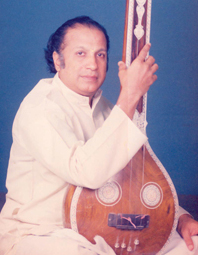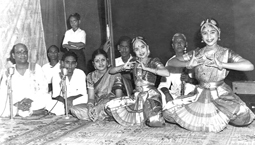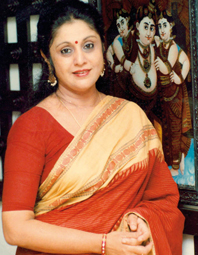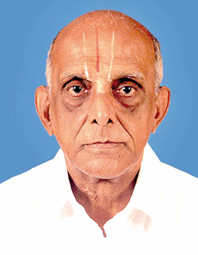COVER STORY - A proud disciple of GNB by M.V. SWAROOP

Trichur Ramachandran’s striking features, crisply ironed clothes, bright eyes and dignified bearing evoke memories of a bygone era of regal presences. He seems to barely pause to think when he speaks, yet he speaks as if he were reading off a script, with his ideas well-formed, his voice clear, and his delivery near-perfect. Speaking of his guru G.N. Balasubramanian, he says, “He was in the music field, but he had the bearing of an officer. Like a minister or something,” cheekily adding, “a minister of those days.” You could say the same about Ramachandran.
Ramachandran’s music resembles GNB’s music more than the music of any other GNB disciple does. When he moved to Madras to learn from the master, Ramachandran lived in a humble room, but spent most of his time at his guru’s house. “It was like gurukulavasam,” he says. “He made me sit next to him, and we had our meals together.”
GNB taught him many compositions, meticulously ensuring that he grasped every nuance perfectly. Most of the manodharma was however something he learnt by osmosis, by being around his guru, listening, observing and absorbing. GNB always stressed that he should understand the ‘why’ and ‘how’ of things. His was a researcher’s mind, always questioning, always rationalising, and his music was scholarly and impulsive at once. Ramachandran too adopts this approach to this day.
SPECIAL FEATURE - Singing for dance – and for Tamil by GOWRI RAMNARAYAN

The 1940s saw M.S. Subbulakshmi in a new role. Ten-year-old Radha and Kalki’s twelve-year-old daughter Anandhi were being groomed in Bharatanatyam by Vazhuvoor Ramiah Pillai. The girls had the privilege of MS singing at their rehearsals and performances. Their enjoyment doubled when MS donned her red dance costume and joined them as they practised adavu-s. Having watched Balasaraswati from her youth, MS instinctively knew abhinaya. Ramiah Pillai would teach the girls the gestures for the padam-s and say, “Ask Amma to show you how to do the abhinaya.” Anandhi remembered how she once struggled to show the feelings of the yearning nayika asking her friend to bring her lover forthwith, in the Kambhoji padam Padari varugudu, and MS stopped singing and demonstrated seven or eight different ways of calling upon the friend – by turns testy, angry, pleading, authoritative, ironic, piteous. “This is how Bala did it,” MS ended. If Radha had a problem in Taaye Yasoda (Todi) over the gopi’s annoyance at Krishna’s pranks, MS would demonstrate how to show that anger with affection and humour.
The girls made their debut in 1945 at the Mylai Sangeeta Sabha, with Tiruppugazh Mani T.M. Krishnaswami Iyer, then Prime Minister of Travancore, as chief guest. Their costumes were made from a gorgeous tissue saree that MS had worn in the film Meera.
SPOTLIGHT - “Dance is a window to a larger culture” by AKHILA KRISHNAMURTHY

Chennai-based internationally acclaimed Bharatanatyam dancer Chitra Visweswaran on her mindspace and why a multi-layered approach to dance is a step in the right direction for dance, and dancers.
The library on the first floor of CAPA (Chidambaram Academy of Performing Arts), Chitra Visweswaran’s 30-year-old institution at Alwarpet, Chennai, is large, both in terms of size and variety. In it, books on dance, music and the
performing arts rub backs with writings on art, architecture, science, spirituality, poetry and philosophy. Downstairs, in her home, where a love for art and aesthetics combine with a sense of hospitality, Chitra prides herself on a personal collection that she and her late husband Visweswaran, together, sowed and grew over the years. In many ways, Chitra is like her library – hearty, generous, open-minded and eclectic.
“Cross-pollination,” she says, “is an important aspect of growth in any culture.” Chitra is sitting on a three-seater sofa in her living room where lamps and lights add a warm glow to a room full of curios, paintings and concepts that find interesting re-interpretations on the walls and the door. “I like to keep a good home; you can say it’s my way of letting my hair down,” she says, as a preamble to our 90-minute long conversation that cruises seamlessly through dance, art, spirituality, yoga, books, life, and of course the length and breadth of India, and important performing centres in the world, “The excitement in my life is that every day is dynamic.”
SPOTLIGHT - J. Venkataraman: an accomplished teacher by LALITHA RAM

If performing musicians are the superstructure, those who mould them are the foundation. J. Venkatraman (JV) is one such accomplished guru. The Music Academy will confer the title Sangita Kala Acharya on him this season.
Rhythm can be said to be JV’s musical USP, just as the Alathur Brothers came to be identified with their laya excellence and their hard work in that aspect of music at a time when Madurai Mani Iyer was renowned for his quietude, Chembai for his bright singing and GNB for his innovations. JV too has put in enormous effort in perfecting rhythm. He can effortlessly render the most complicated tight-rope walking in swara permutations. Living on at Tiruchi, not moving to Chennai in search of concert opportunities, he has trained pupils for nearly sixty years. One of his prominent disciples is Pradeep Kumar, a rising prospect in the kutcheri scene.


